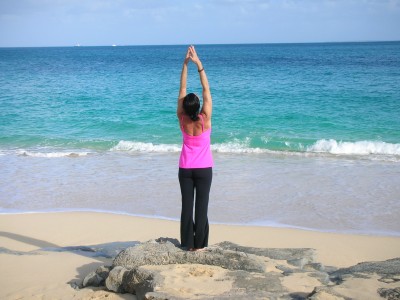
We’re up to Chapter 18 in the daily blog tour of my book, “Stretched, Build Your Yoga Business, Grow Your Teaching Techniques.” I love going through the content of the book as a preview and hope it interests you enough that you’ll buy it when it comes out ( I hope to get the final copy today). Today’s chapter is called, “Facing Your Fears as a Yoga Teacher.” For those of you that don’t teach, you might chuckle at this one, thinking, “What could be so scary about teaching yoga?” Well, it’s just one of those things you have to experience to know. While it does vary from person to person, teaching yoga is just one of those things that brings us right up against ourselves. And, we’ve got a choice to either get stuck in thinking or, as they say, get out of our own way.
In this chapter, I lay out some of the fears that I’ve felt, some of what I’ve heard from others and some of what I imagine might be going through teachers’ minds as they teach. Sometimes it’s just in the discussion of the fear that we can dispel it but some of these fears, depending on our personality and life story, can really run deep. Fear as a teacher can get in the way of our being authentic, can block our naturalness and can make us jump to assumptions and taking things personally when it comes to students (see also the book, “The Four Agreements,” Don Miguel Ruiz). Fear around teaching can be felt not only in the context of actual teaching but can be felt around the idea of our futures as teachers, our reputation and future opportunities.
One of the fears I discuss in this chapter is: ” I don’t think they like this class.” Have you ever thought that while teaching? Teachers have a way of sensing the energy in the room. Sometimes, you can feel like the class is falling flat and might attribute it to the students not enjoying class. This is always an interesting assumption/fear because honestly, how do you know if they like it or not? They’re not saying anything. They’re not leaving (hopefully). So, what exactly IS it that leads you to think this? Well, it’s fear. We can jump to conclusions, we can make assumptions, we can try to read facial expressions and from them, conclude certain things. We can look at the person who maybe grimaces or looks like they just rolled their eyes or even the student that DOES get up and leave. Why does any of that have anything to do with us? Because our ego often gets in the way of us seeing things clearly. As we teach, it’s important that we remember that we have no idea what the students in class are thinking and even if they give us feedback at the end that is uncomplimentary, maybe that’s not such a big worry anyway. There are lots of yoga classes, lots of teachers and how can we possibly be the teacher for everyone? We can’t. All we can do is teach with truth and integrity and let that stand on its own.
This is a topic that I love to discuss with new teachers because I believe that these fears are out there and they’re often not discussed. By bringing them into the light, we can dispel their power and allow teachers to tap into the resident power of authenticity they have within (see also the book, “Return to Love,” Marianne Williamson). More experienced teachers have gone through these ups and downs and by sharing these feelings honestly, we empower ourselves and others to be the best teachers they can be.
Next Up: Chapter 19, Teaching Yoga to Beginners.
